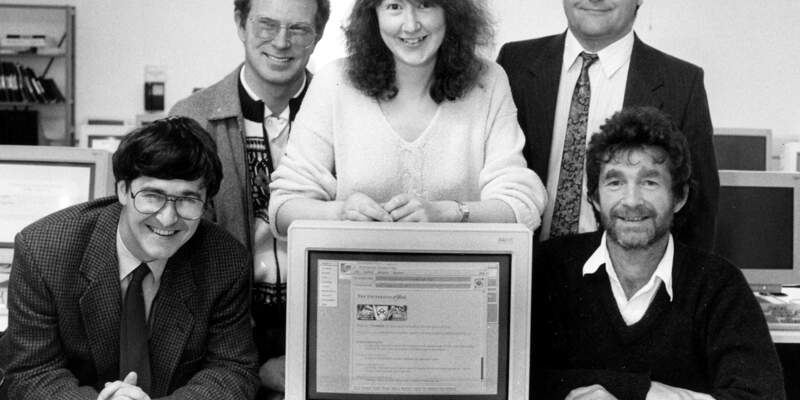
Our history
A lot has changed over the past 60 years. There have been computing facilities at the University since 1966 but there was once a time when it seemed unbelievable that the University would generate more than 12 megabytes of data.
We started in 1966 with just a single computer, which could read paper tapes. Though it might not seem it by today's capabilities, we were actively embracing technology. Over the decades, we've vastly expanded our IT-related departments, research, facilities and networks. So much so, during the Covid-19 pandemic, we were able to set up a sophisticated testing centre to help the local York community. Today, we continue to embrace and innovate with technology, celebrating our milestones along the way.
Browse by decade:
1960s | 1970s | 1980s | 1990s | 2000s | 2010s | 2020s
1960s
1966
The Department of Computation opened, providing a computing service to the University. The ‘Flowers Report’ (Cmnd 2883) recommended computers for research in all universities. York started the Department of Computation, appointing David Burnettt-Hall as Director.
1967
This year saw the installation of the Elliott (ICL) 4130 computer, which remained in service until 1976.
The initial system comprised a 4130 processor, 16Kb (24 bit) of memory, a card reader, a paper tape reader and punch, 3 tape drives and a graph plotter. However, even before delivery, it was found that the operating system would not fit on the 16Kb memory, so this was upgraded to 32Kb.
Computing service started as Computation (computing with numbers) for research (predominantly in STEM departments) as envisaged in the Flowers Report.
1969
At the end of 1969, the Computer Board funded a further upgrade of three 4Mb disks, together with an Autonomous Transfer Unit which allowed data transfer directly between the store and tape and disk subsystems, without interrupting the central processor. The University considered purchasing a fourth 4Mb disk drive but decided not to, because it was inconceivable that the University would ever generate that amount of data.
Teaching Computation started as a subsidiary subject with Mathematics.
1970s
In the space of five years, computing at York had changed from punched card input with line printer listing output to a style of use that is now familiar to 21st century users. Though by modern standards the facilities were rudimentary, by the end of the 1970s we were providing interactive computing together with access to a national network.
1970
At the beginning of 1970, a Computer Manager was appointed, to be followed in the summer by two fellows, one to look after systems programming and one for applications. A Computing Assistant was also appointed.
1971-73
A Professor of Computer Science, Ian Pyle was appointed. The scope of the department was expanded to include all kinds of use of computers, not just computing with numbers or research.
1975-76
The Computing Service was established as part of the Computer Science department from 1975. The Computing Service building was constructed in 1976 and provided a public reception area, as well as housing staff offices and the server room.
In 1975 it was agreed to purchase a DEC System 10, which was installed in 1976. The old system (4130) had to be removed to make space for it, and the installation took two months - during this time, computing facilities were provided to York by the universities of Leeds and Manchester.
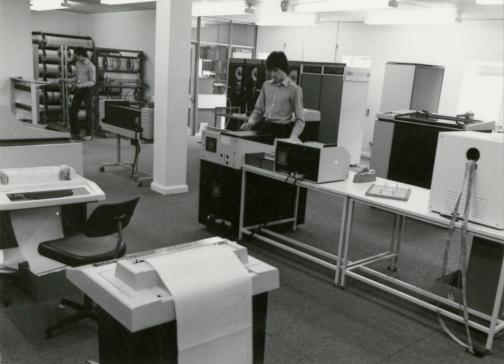
Server room with DECsystem-10 mainframe computers, in Computing Service, 1970s
1979
As users became more familiar with interactive computing, their demands and expectations grew. To meet the increasing workload, the Computer Board agreed to a request for a substantial upgrade. This was installed in January 1979 and included a more powerful processor, a second disk channel and a 200Mb disk drive. At the same time, various upgrades to the communication system meant that our users could contact some other universities and science research council sites.
1980
By this stage, access to computing facilities was vital to many students. In June 1980, a student was thrown into the University lake by a group of his peers for creating a programme which took an entire terminal room out of commission. The student concerned was suitably chastened and even sent an apology, which was published in the Computing Service newsletter, Printout.
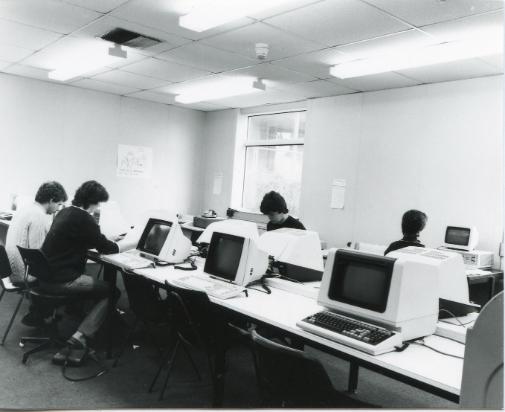
Students working in a terminal room in the Computing Service building, 1980s
1982
The DEC System 10 was augmented in early 1982 by the addition of a KS10 system roughly one fifth of the power of the existing KL10.
1983
Planning for the future of computing at the University was based on the intended implementation of a powerful system being developed by DEC, codenamed Jupiter. However, in the Spring of 1983 at a DECUS conference in the United States, DEC announced the abandonment of this project, declaring that the future lay with the VAX series of mid-range systems. DEC anticipated such hostility to this announcement that the DEC vice-president who made it was protected by armed guards at the meeting. As a result of the cancellation of the Jupiter project, it was realised that there was no future in continuing with the DEC System 10.
The Computing Service, formerly part of Computer Science, became an independent entity from 1 April.
1985-86
In July 1985, the University invited tenders for a replacement system to be installed in the Summer of 1986. The requirements called for a system capable of supporting 120 simultaneous users. After considerable investigation and debate, it was decided to proceed with the DEC offer of a VAX 8600, together with a smaller VAX system. The new systems were installed in the Summer of 1986 and at the start of the new academic year were subjected to a load test, with large numbers of users being asked to simultaneously input test scripts. The systems were unable to support the workload of 120 simultaneous users, so eventually, DEC replaced the small VAX system with a VAX 8550. This configuration worked well and continued to provide the backbone of the University's computing facilities until the early 1990s via a network of VDU terminals across the campus, including an ever-growing number of terminal rooms for student use.
A new user registration system called Regi, which was written in-house, was brought into service to manage user accounts. The descendant of this is still in use today.
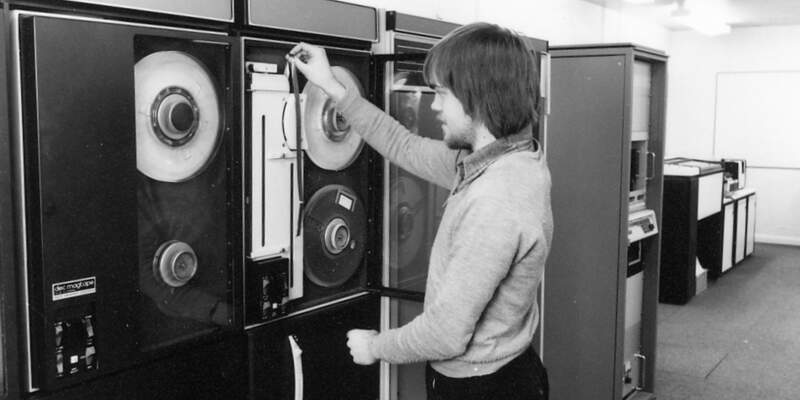
A DEC System 10 at the University, 1986
1988
The Review of the Computing Service identified a set of core and non-core services; the latter were chargeable and the former were not. The charges were determined annually by the University's Information Committee.
1990-91
In the early 1990s, the PC began to figure largely in the University’s provision of computing power. Though a classroom of Silicon Graphics Indigo workstations running UNIX was installed in 1990, it was the PC using Intel or compatible processors together with successive versions of the Microsoft Windows operating system, that proved most popular with users whether staff or student. The Computing Service installed the first PC classroom in Langwith 117 in September 1991, and were soon installing new PC rooms as fast as the University could afford them.
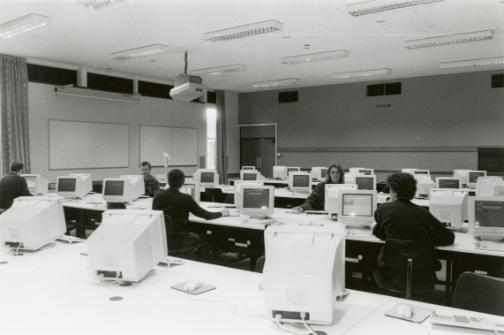
1994
YorkWeb was launched on 19 September 1994, providing the University with an online presence.
1995
The Computing Service introduced the Iliad course (Information literacy in all departments) which was delivered in conjunction with the Library, offering IT and information handling skills for new students. Students attending the course gave positive feedback, and the training continued to prove popular over the coming years. At the time, it was said the course 'encourages greater personal confidence in using IT and prove it’s not impossible for anyone to get to grips with a PC'.
2000s
2000
The Computing Service began a project to evaluate virtual learning environments - the product initially under consideration was WebCT, but the University later settled on Blackboard.
The student training course, Iliad, was supplemented by training aimed at 2nd and 3rd year students, Iliad for the Workplace, which focused on advanced use of packages like Word, Excel, Access and Netscape Composer (a web authoring tool).
A ColdFusion service and training course were introduced to enable web authors to create dynamic content.
We trialled the use of adverts on classroom PCs as a fundraising initiative. It proved unpopular with students, and has not been repeated.
2001
The University moved from the Corel Office suite to Microsoft Office as its main office software - some people were outraged, others saw it as a necessary move. The Computing Service newsletter, Keynotes, advised people not to send email attachments in .doc format, as they were the file format most prone to virus infection.
2002
A pilot service was implemented to provide internet connections in college accommodation, initially in selected blocks in Halifax and James Colleges. Students in accommodation with the connection paid £60 a year to use the service. Over the following years, this service was rolled out to cover all on-campus college accommodation, and some off-campus accommodation, and the cost was incorporated into the accommodation charge.
2009
Construction work had begun on Heslington East, and the new campus was connected to the University network, with an 1.83 kilometre length of multicore fibre blown down a tube connecting the two campuses.
The Computing Service began using Twitter to communicate information about new services, downtimes, hints and tips, and to respond to service users’ questions.
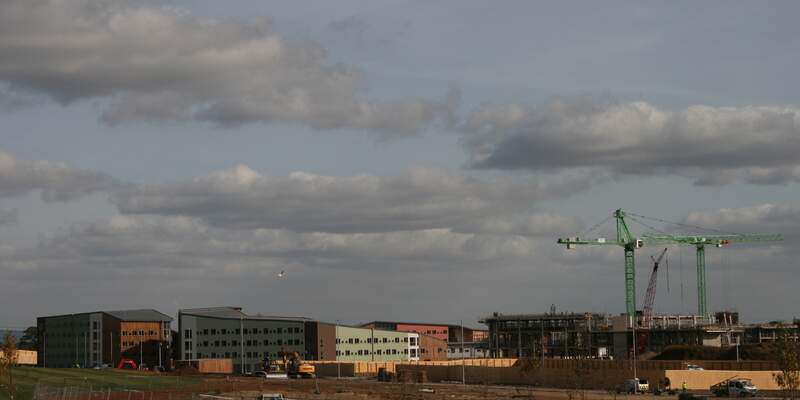
Campus East under construction, 2007
2011
The academic year 2011 - 12 saw the introduction for Google Apps for Education, which gave staff and students access to a vastly increased email quota, a new calendar tool, and apps to support collaborative working. The implementation of this won a VC’s Gold Award for Excellence.
The Harry Fairhurst building opened in April 2011. Named after the first University Librarian, it was designed as an IT-rich flexible learning space.
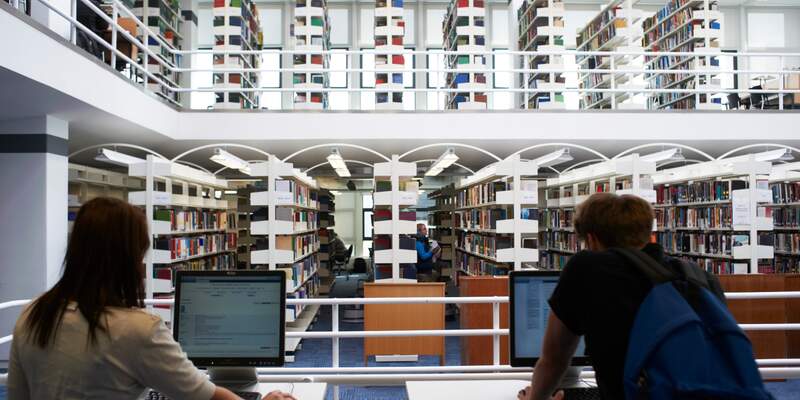
Students using the newly opened Harry Fairhurst building, 2011. (Copyright John Houlihan, johnhoulihan.com)
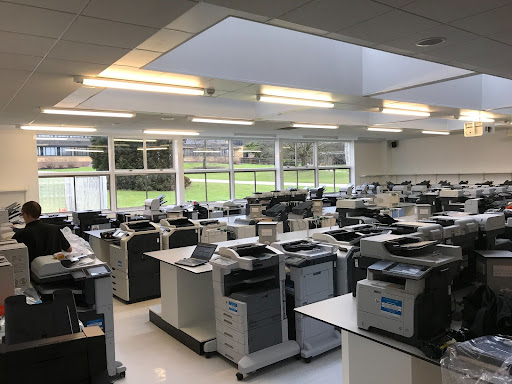
Between 2011 and 2016, the centralised printing service YPP was rolled out across campus. The original survey and report by consultants Insatsu Chosa found 1,909 print devices onsite costing £44K per month to run (printing around 2M sides per month). A project group was formed and suppliers engaged to reduce the number of devices, costs and environmental impact. Rollout of new hardware went building by building over the next few years reducing the number of print devices to around 400, a mix of floorstanding multifunction printers and desktop print hardware. Estimated savings are 24% cost, 52% energy and 35% CO2, the print volume reduced over this period to around 1.75M per month.
2012
After previously rejecting the use of 'the Cloud' following investigations in 2009, in 2012 we convened a Cloud Working Group with 'a remit to advise the University on appropriate strategy and policy within this area.'
2013
The Managed Linux Desktop service was introduced in 2013 to provide centrally-supported operating systems and applications. Computer Science acted as the lead department, migrating their classroom and office PCs during the summer and winter holidays and other departments then followed, replacing their locally-managed or unmanaged PCs.
2014
In partnership with City of York Council the Eduroam wifi network was implemented across York City Centre and CityConnect was provided as wifi networks for visitors on campus to use.
The first outdoor wifi network was also introduced in 2014.
IT Services introduced YARCC (York Advanced Research Computing Cluster). It was a first attempt at a high performance computing cluster. At its peak it had 85 nodes, but due to budget constraints many of them were second hand.
The University’s connection to the Internet is upgraded from 2Gbps to 4Gbps.
2015
The University’s connection to the Internet is upgraded from 4Gbps to 10Gbps.
This was also the year the IT Support team celebrated resolving 200,000 queries.
2016
Our end to end monitoring processes, which includes our status board, was commened at the UCISA Award for Excellence.
2017
After a multi-year effort for the team to join IT Services, a Head of Faculty IT was appointed in 2017.
The University was awarded the 'Best Student Broadband' in the National Student Housing Awards.
2018
In 2018, printing hardware was refreshed across campus. Moving to ink based print for colour and newer devices reduced CO2 output by 71% and further reduced costs by 17%.
IT Services deployed its first production application to the cloud using Amazon Web Services.
The internationally recognised ISO 27001 certification was achieved by the Data Safe Haven team, with the launch of a new service that provides a secure environment for undertaking research using personal, sensitive or confidential data.
The Research Systems Support Hub was established to provide dedicated IT support for users of research systems at York. Research Systems now supports seven research systems: Worktribe, Pure, SciVal, Research Professional, Covidence, Administrate and ResearchFish.
The new high performance compute cluster named Viking was launched, replacing YARCC.
2020
In March 2020, government guidelines designed to help stop the spread of Covid-19 meant that University staff were required to work from home and IT Services were forced to provide 100% of support remotely for the first time. In September, the service returned to in-person support.
The pandemic also led to over 2,000 laptops being provided to staff across the UK and the implementation of Zoom across the organisation so staff could conduct virtual meetings.
September saw IT Services join the newly formed Directorate of Technology, Estates and Facilities (DTEF).
In November 2020, IT Services helped to set-up a Covid-19 testing centre in York Sports Centre. This involved many different areas of IT including data, networking, desktop IT and print infrastructure.
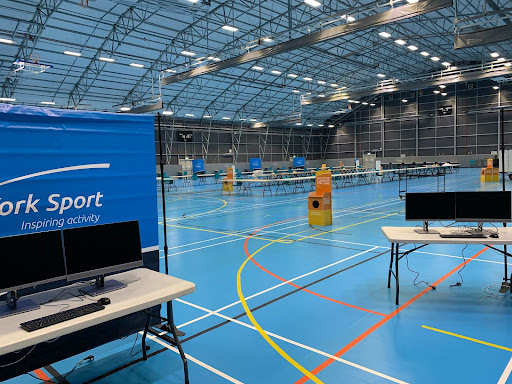
Covid testing taking place in York Sports Centre, 2020
2022
The Network team set up data networks across a number of new buildings and refurbishments during this decade including in 2022 in the new David Kato College, which has over 700 bedrooms, and as part of the York Management School refurbishment.
The Desktop, Print and Services team and Networks team moved from X Block to Quantum House.
2023
In early 2023, the Audio Visual department became part of IT Services. AV provides equipment and technical staff to support teaching and conferences across the University as well as maintain AV equipment in teaching rooms.
Azure Virtual Desktop is launched. This replaces the Virtual Desktop Service providing remote access to many University apps. Hardware that underpins the previous service was powered on 24x7, while the use of cloud computing now enables the service to grow and contract in real-time to match usage patterns throughout the year. This results in huge power savings and carbon efficiencies.
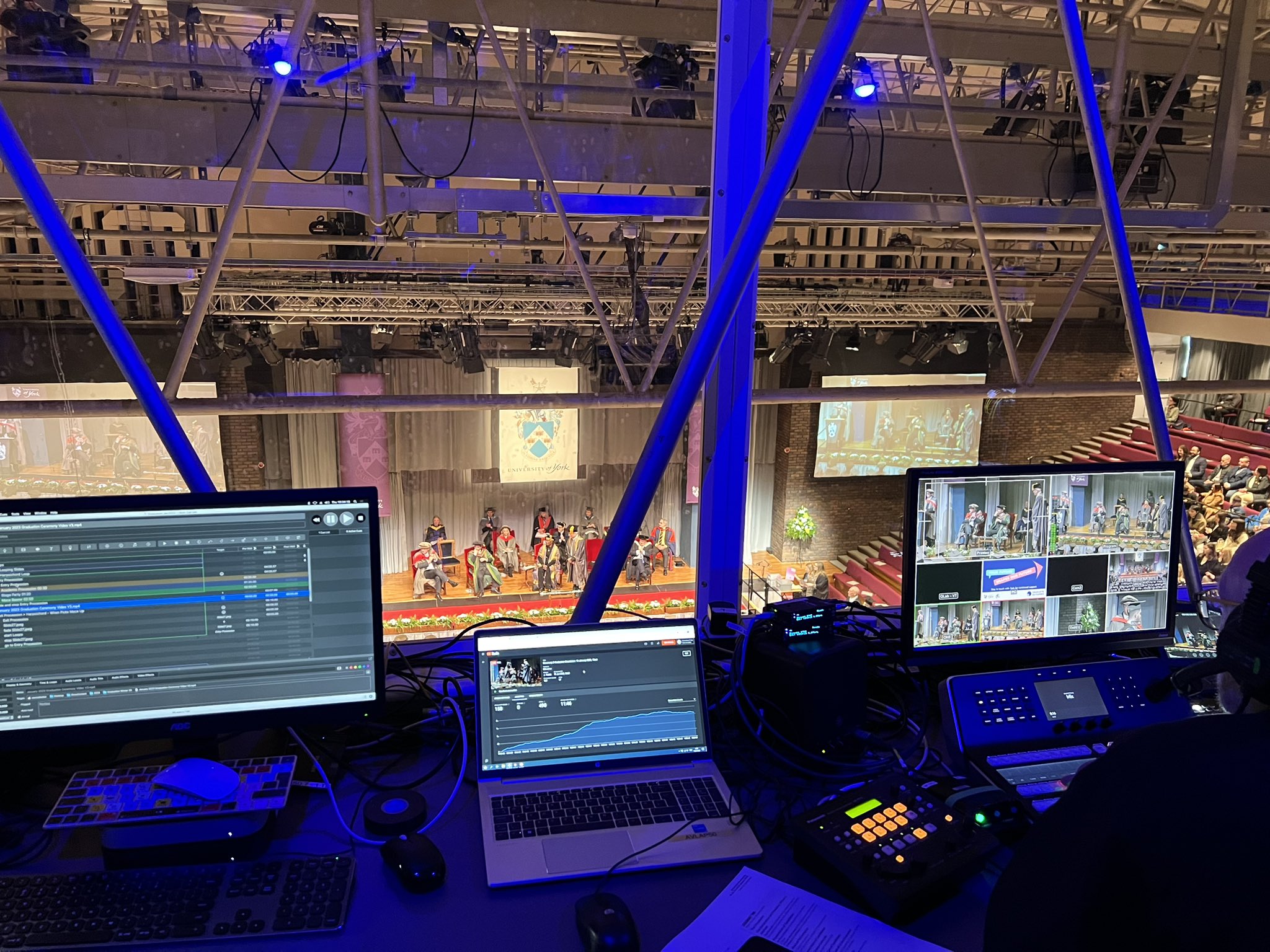
Audio-Visual department assisting with a York graduation ceremony.